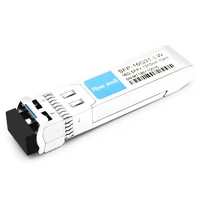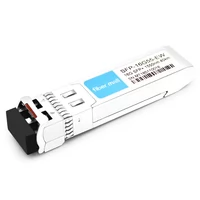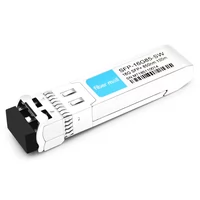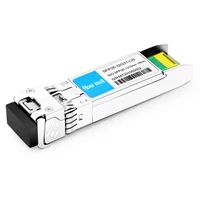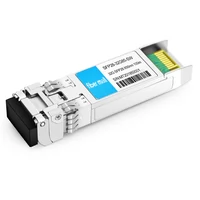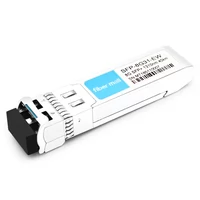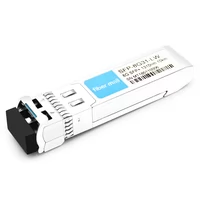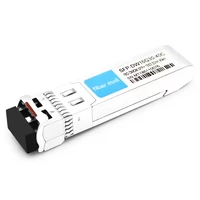Fibre Channel is a kind of network storage switching technology that provides long distances and high bandwidth, enabling the transfer of large data files between storage, servers, and clients.
Fibre Channel (FC) is a high-speed network interconnection technology (usually running at 2Gbps, 4Gbps, 8Gbps, 16Gbps, and 32Gbps), which is mainly used to connect computer storage devices. In the past, Fibre Channel was mostly used for supercomputers, but now it is also becoming a common connection type in an enterprise’s Storage Area Network (SAN). Despite being called fibre channel, its signals can also run over twisted-pair cable.
1. The Features of Fibre Channel Transceiver
Fibre channel transceivers are used for fibre channel storage network links in data centers. It includes transmitting, receiving, clock data recovery, and control. The optical modules of fibre channel can be downward compatible with the application, support the diagnostic test of the optical loop and circuit loop, and provide a stable receiving alarm. As the interface between fibre channel systems and optical network storage devices, it has the characteristics of miniaturization and low power consumption and can improve the density of the port application. In addition, the fiber channel transceiver is hot-pluggable, which is convenient for system debugging on-site, and supports a digital diagnostic interface. The network management can monitor the working status of the optical module through the communication interface.

2. Why do Data Centers Need Fibre Channel Transceivers?
- Availability: Data storage for core services cannot be interrupted, and Fibre Channel networks can ensure that data is accessed in real-time.
- Performance: Fibre channel transceivers can provide better performance for core service.
- Expansibility: Fibre channel network can ensure that when the business expands and storage capacity increases, there is a corresponding network foundation that can support such a business system.
- Security: Fibre channel is a natural security system. A hacker can attack the ID network inside the data center and attack the servers, but he cannot attack your storage network because the SAN(Storage Area Network) is naturally isolated from the outside world. SAN can protect data and reduce the risk of data leakage
3. What is the Difference Between a Fibre Channel Transceiver and an Ethernet Transceiver?
Transport Protocol
Fibre channel transceivers and Ethernet optical modules follow different protocols. Fibre channel transceiver belongs to Fibre channel protocol and does not follow OSI (Open System Interconnection Reference Model), while Ethernet optical module complies with IEEE 802.3 standard for packet-based physical communication in a LAN(Local Area Networks). It is the data link layer protocol in the TCP/IP Protocol Stack and belongs to the OSI model. Fibre channel transceivers are compatible with the Ethernet protocol, while Ethernet optical modules do not support the Fibre Channel protocol.
Reliability
Fibre channel transceivers offer better reliability. They are designed for users who are looking for high speed, low latency for block storage. If users need file-level storage access, Ethernet modules are preferred.
Transmission Rate
At present, fibre channel transceiver support rates of 1Gbps, 2Gbps, 8Gbps, 16Gbps, 32Gbps, and 128Gbps, while Ethernet modules can support a larger range of transmission speeds: 10/100/1000Mbps and 10Gbps, 25Gbps, 40Gbps, 50Gbps, 100Gbps, 200Gbps, 400Gbps.
In addition, the update iteration speed of fibre channel transceiver is slow, from 1Gbps to 128gbps. Obviously, the capacity and output of the Ethernet module are much higher than that of fibre channel module. The 400G Ethernet QSFP-DD module is nearly 400 times the original 1G SFP module. Therefore, Ethernet optical module is more in line with the increasing demand for high bandwidth than fibre channel optical module.
Application
Traditional fibre channel network, including fibre channel switch and fibre channel HBAs, is one of the main choices of SAN. Fibre channel switches connect storage to the SAN, while fibre channel HBAs connect switches to servers. Fibre channel is one of the best ways to transfer large amounts of data between servers and storage devices. Through fibre channel protocol (FCoE), fibre channel communication can run on Ethernet. Fibre channel transceivers have been used in large enterprises and data centers for a long time.

Ethernet optical modules are typically used in LAN(Local Area Networks) and sometimes in WAN(Wide Area Networks). Compared to the working scenario of Fibre channel transceivers, the application environment of Ethernet modules is more flexible and diverse based on the user’s bandwidth requirements and can be found in a variety of settings, from small offices to hyper-scale data centers. Ethernet network switches are versatile in terms of stackability, the number of ports, transmission rates, etc.
4. Summary
For the rapidly transforming data center, in order to meet the high I / O and high-performance requirements of all-flash memory arrays, the 6th generation 32Gbps module of FC SFP+ is particularly important. When enterprises use flash memory to redesign their data center and optimize application performance, they need low latency, high capacity bandwidth and a reliable network. At present, 70-80% of flash array storage systems have been deployed using fibre channels. In the future, next-generation flash storage based on the non-volatile memory standard (NVMe) will be seamlessly integrated with 6th-generation Fibre Channel networks.
FiberMall’s fibre channel transceiver series includes 8G, 16G, and 32G optical modules. Compatible with BROCADE, HPE, IBM, Cisco, Juniper Networks, Qlogic, H3C, HW and other brands of Fibre Channel switches.
| Model | Description |
|---|---|
| SFP-8G85-SW | 8G FC SFP+ 850nm 300m |
| SFP-8G31-LW | 8G FC SFP+ 1310nm 10km |
| SFP-8G31-EW | 8G FC SFP+ 1310nm 40km |
| SFP-8G55-EW | 8G FC SFP+ 1550nm 40km |
| SFP-8G55-ZW | 8G FC SFP+ 1550nm 80km |
| SFP-16G85-SW | 16G FC SFP+ 850nm 100m |
| SFP-16G31-LW | 16G FC SFP+ 1310nm 10km |
| SFP-16G55-EW | 16G FC SFP+ 1550nm 40km |
| SFP-16G55-ZW | 16G FC SFP+ 1550nm 80km |
| SFP-CW16GXX-40C | 16G FC CWDM SFP+ 1470~1610nm 40km |
| SFP-DW16GXX-40C | 16G FC DWDM SFP+ 1528.77~1563.86nm 40km |
| SFP28-32G85-SW | 32G FC SFP28 850nm 100m |
| SFP28-32G31-LW | 32G FC SFP28 1310nm 10km |
Table of Contents
ToggleRelated Products:
-
 SFP-16G31-LW 16G SFP+ LW 1310nm 10km LC SMF DDM Transceiver Module
$85.00
SFP-16G31-LW 16G SFP+ LW 1310nm 10km LC SMF DDM Transceiver Module
$85.00
-
 SFP-16G55-EW 16G SFP+ EW 1550nm 40km LC SMF DDM Transceiver Module
$255.00
SFP-16G55-EW 16G SFP+ EW 1550nm 40km LC SMF DDM Transceiver Module
$255.00
-
 SFP-16G85-SW 16G SFP+ SW 850nm 100m LC MMF DDM Transceiver Module
$45.00
SFP-16G85-SW 16G SFP+ SW 850nm 100m LC MMF DDM Transceiver Module
$45.00
-
 SFP28-32G31-LW 32G SFP28 LW 1310nm 10km LC SMF DDM Transceiver Module
$75.00
SFP28-32G31-LW 32G SFP28 LW 1310nm 10km LC SMF DDM Transceiver Module
$75.00
-
 SFP28-32G85-SW 32G SFP28 SW 850nm 100m LC MMF DDM Transceiver Module
$55.00
SFP28-32G85-SW 32G SFP28 SW 850nm 100m LC MMF DDM Transceiver Module
$55.00
-
 SFP-8G31-EW 8G SFP+ EW 1310nm 40km LC SMF DDM Transceiver Module
$60.00
SFP-8G31-EW 8G SFP+ EW 1310nm 40km LC SMF DDM Transceiver Module
$60.00
-
 SFP-8G31-LW 8G SFP+ LW 1310nm 10km LC SMF DDM Transceiver Module
$20.00
SFP-8G31-LW 8G SFP+ LW 1310nm 10km LC SMF DDM Transceiver Module
$20.00
-
 SFP-DW16G30-40C 16G DWDM SFP+ 100GHz C30 1553.32nm 40km LC SMF DDM Transceiver Module
$400.00
SFP-DW16G30-40C 16G DWDM SFP+ 100GHz C30 1553.32nm 40km LC SMF DDM Transceiver Module
$400.00

